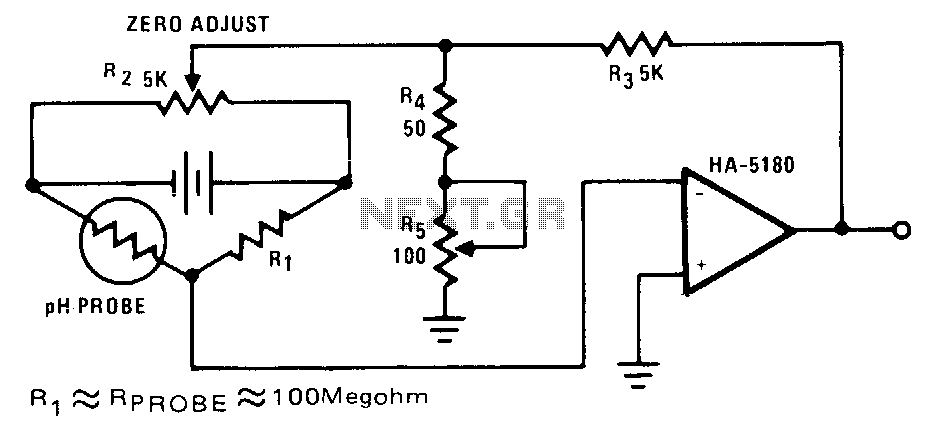
Ph-probe-and-detector

The highest sensitivity is attained when R1 is roughly equal to the probe resistance. The circuit can be calibrated to zero using R2, while R5 regulates the full-scale voltage. The relationship between pH and output voltage may not be linear, which could require the implementation of a shaping circuit. Additionally, a calibration scheme utilizing solutions with known pH values may be sufficient and more dependable over time due to variations in the probe.
In this circuit design, R1 plays a crucial role in achieving optimal sensitivity by matching the resistance of the pH probe. This matching ensures that the circuit can accurately detect minute changes in pH levels, which is essential for precise measurements. The zeroing process facilitated by R2 allows for calibration adjustments, ensuring that the output voltage accurately reflects the pH level when the probe is submerged in a neutral solution, typically at pH 7.
R5 is responsible for controlling the full-scale voltage, which defines the maximum output voltage of the circuit corresponding to the extreme pH values (usually pH 0 to pH 14). This component must be carefully selected to ensure that the output range fits within the specifications of the subsequent data acquisition system or display unit.
The non-linear correlation between pH and output voltage indicates that a simple linear relationship cannot be assumed. Therefore, a shaping circuit may be necessary to linearize the output signal. This can be achieved through various methods, such as using operational amplifiers configured to provide a logarithmic or polynomial response, thereby transforming the non-linear output into a more usable linear format.
Additionally, the calibration scheme that employs solutions of known pH values is vital for maintaining measurement accuracy over time. pH probes can exhibit drift and variance in their readings due to factors such as aging, contamination, or changes in temperature. Regular calibration with standard buffer solutions helps to mitigate these issues, ensuring that the circuit maintains reliable performance and accurate readings throughout its operational lifespan. This approach is particularly important in applications requiring high precision, such as laboratory analysis or industrial processes.The greatest sensitivity is achieved if R1 is approximately equal to the probe resistance. The circuit can be zeroed with R2, while the full-scale voltage is controlled by R5. The correlation between pH and output voltage might not be linear, which would necessitate a shaping circuit. A calibration scheme, using solutions of known pH, might prove adequate and more reliable over a period of time because of probe variance.
In this circuit design, R1 plays a crucial role in achieving optimal sensitivity by matching the resistance of the pH probe. This matching ensures that the circuit can accurately detect minute changes in pH levels, which is essential for precise measurements. The zeroing process facilitated by R2 allows for calibration adjustments, ensuring that the output voltage accurately reflects the pH level when the probe is submerged in a neutral solution, typically at pH 7.
R5 is responsible for controlling the full-scale voltage, which defines the maximum output voltage of the circuit corresponding to the extreme pH values (usually pH 0 to pH 14). This component must be carefully selected to ensure that the output range fits within the specifications of the subsequent data acquisition system or display unit.
The non-linear correlation between pH and output voltage indicates that a simple linear relationship cannot be assumed. Therefore, a shaping circuit may be necessary to linearize the output signal. This can be achieved through various methods, such as using operational amplifiers configured to provide a logarithmic or polynomial response, thereby transforming the non-linear output into a more usable linear format.
Additionally, the calibration scheme that employs solutions of known pH values is vital for maintaining measurement accuracy over time. pH probes can exhibit drift and variance in their readings due to factors such as aging, contamination, or changes in temperature. Regular calibration with standard buffer solutions helps to mitigate these issues, ensuring that the circuit maintains reliable performance and accurate readings throughout its operational lifespan. This approach is particularly important in applications requiring high precision, such as laboratory analysis or industrial processes.The greatest sensitivity is achieved if R1 is approximately equal to the probe resistance. The circuit can be zeroed with R2, while the full-scale voltage is controlled by R5. The correlation between pH and output voltage might not be linear, which would necessitate a shaping circuit. A calibration scheme, using solutions of known pH, might prove adequate and more reliable over a period of time because of probe variance.